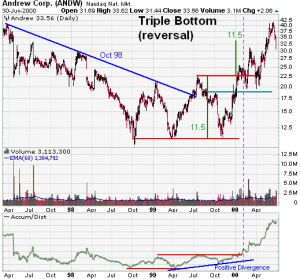The triple bottom is a reversal pattern made up of three equal lows followed by a breakout above resistance. While this pattern can form over just a few months, it is usually a long-term pattern that covers many months.it is a pattern used in technical analysis to predict the reversal of a prolonged downtrend. The pattern is identified when the price of an asset creates three troughs at nearly the same price level. The third bounce off the support is an indication that buying interest (demand) is outweighing selling interest (supply) and that the trend is in the process of reversing. Because of its long-term nature, weekly charts can be best suited for analysis. lets examine the individual parts of the pattern

1.
Prior Trend: With any reversal pattern, there should be an existing trend to reverse. In the case of the triple bottom, a downtrend or long trading range should be in place. Sometimes there will be a definitive downtrend to reverse. Other times the downtrend will fade away after many months of sideways trading.
2.
Three Lows: All three lows should be reasonable equal, well spaced and mark significant turning points. The lows do not have to be exactly equal, but should be reasonably equivalent.
3.
Volume: As the triple bottom develops, overall volume levels usually decline. Volume sometimes increases near the lows. After the third low, an expansion of volume on the advance and at the resistance breakout greatly reinforces the soundness of the pattern.
4.
Resistance Break: As with many other reversal patterns, the triple bottom is not complete until a resistance breakout. The highest point of the formation, which would be the highest of the intermittent highs, marks resistance.
5.
Resistance Turns Support: Broken resistance becomes potential support, and there is sometimes a test of this newfound support level with the first correction. Because the triple bottom is a long-term pattern, the test of newfound support may occur many months later.
6.
Price Target: The distance from the resistance breakout to lows can be measured and added to the resistance break for a price target. The longer the pattern develops, the more significant is the ultimate breakout. Triple bottoms that are 6 or more months in duration represent major bottoms and a price target is less likely to be effective.
As the triple bottom develops, it can start to resemble a number of patterns. Before the formation of third low , where the pattern may look like a double bottom. Three equal lows can also be found in a descending triangle or rectangle. Of these patterns mentioned, only the descending triangle has bearish overtones; the others are neutral until a breakout occurs. Similarly, the triple bottom should also be treated as a neutral pattern until a breakout occurs. The ability to hold support is bullish, but demand has not won the battle until resistance is broken. Volume on the last advance can sometimes yield a clue. If there is a sharp increase in volume and momentum, then the chances of a breakout increase.